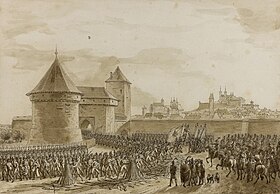| Capitulation of Erfurt | |||||||
|---|---|---|---|---|---|---|---|
| Part of the War of the Fourth Coalition | |||||||
 Surrender of the Prussian troops after the capture of the city of Erfurt, 16 October 1806 Drawing by Benjamin Zix, 1806 | |||||||
| |||||||
| Belligerents | |||||||
|
|
| ||||||
| Commanders and leaders | |||||||
|
|
| ||||||
| Strength | |||||||
| 16,000 | 10,000[1]–12,000, 65 guns | ||||||
| Casualties and losses | |||||||
| None | 10,000[1]–12,000, 65 guns | ||||||
In the Capitulation of Erfurt on 16 October 1806, a large body of troops from the Kingdom of Prussia under Lieutenant General the Prince of Orange surrendered to Marshal Joachim Murat of France, at the city of Erfurt (now in Germany). The Prussian soldiers were demoralized by their shattering defeat at the Battle of Jena–Auerstedt on 14 October and unwilling to put up much resistance. The event occurred during the War of the Fourth Coalition, part of the Napoleonic Wars. Erfurt is located on the Gera River about 40 kilometers west of Jena.
Only eight days before, Emperor Napoleon I of France invaded the Electorate of Saxony with a large army and quickly inflicted two minor setbacks on his enemies. This was followed by the catastrophe of 14 October. In the aftermath of the battle, the organization of the Prussian army disintegrated. Large numbers of Prussian fugitives from the battle entered Erfurt and could not be induced to leave. When Murat's French cavalry arrived before the city, it was surrendered without any fighting.
- ^ a b c Bodart 1908, p. 373.
